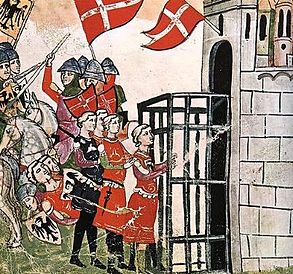Battle of Fossalta
| Battle of Fossalta | |||||||
|---|---|---|---|---|---|---|---|
| Part of Guelphs and Ghibellines | |||||||
 Battle of Fossalta and king Enzio captured |
|||||||
|
|||||||
| Belligerents | |||||||
|
Ghibellines: Cremona and Modena |
Guelphs: |
||||||
| Commanders and leaders | |||||||
|
Enzio of Sardinia Buoso da Dovara |
Filippo Ugoni Ottaviano degli Ubaldini Antonio Lambertacci |
||||||
| Strength | |||||||
| 15,000 | 8,800 | ||||||
| Casualties and losses | |||||||
| Heavy Also king Enzio and 400 knights captured |
Heavy | ||||||
The Battle of Fossalta was an episode of the War of the Guelphs and Ghibellines in Northern Italy. It took place in Fossalta, a small location on the Panaro river, and is especially remembered for the capture of Enzio of Sardinia, son of Emperor Frederick II of Hohenstaufen.
In the spring of 1249, a Guelph Romagnol army of the Lombard League advanced to the Panaro. The army was composed of 3,000 Knights and 2,000 foot soldiers from the Margrave Azzo VII d'Este and 1,000 Knights and 800 foot soldiers of Bolognese militias from Porta Stieri, Porta San Procolo and Porta Ravegnana. The army was led by the Brescian Filippo Ugoni, who had victoriously defended Milan while besieged by Emperor Frederick II, and accompanied by Ottaviano degli Ubaldini, the Cardinal of Bologna.
The Guelph army threatened the Ghibelline city of Modena and therefore the Modenese had requested help from Enzio of Sardinia, who was then imperial vicar in northern Italy, and resided at Cremona.
Enzio organised a massive army of 15,000 men, composed of Imperial Germans and Lombard Ghibellines from Cremona and Modena. He led the army across the Po by using his self-constructed bridge at Bugno. They arrived at the Fossalta stream, some 5 km north of Modena.
...
Wikipedia
